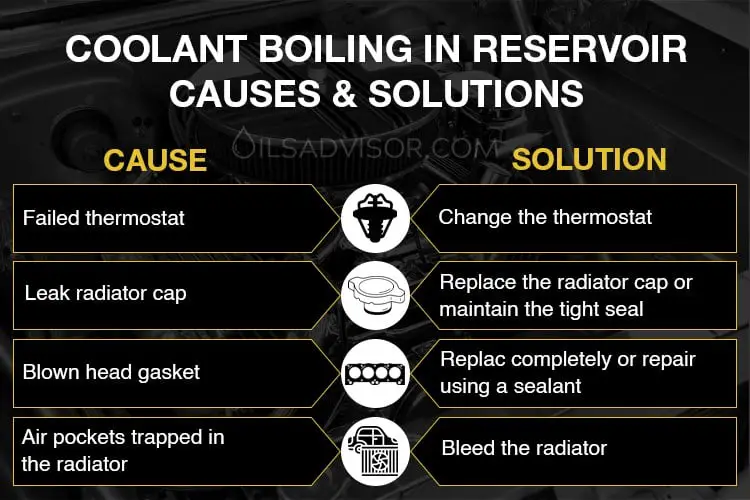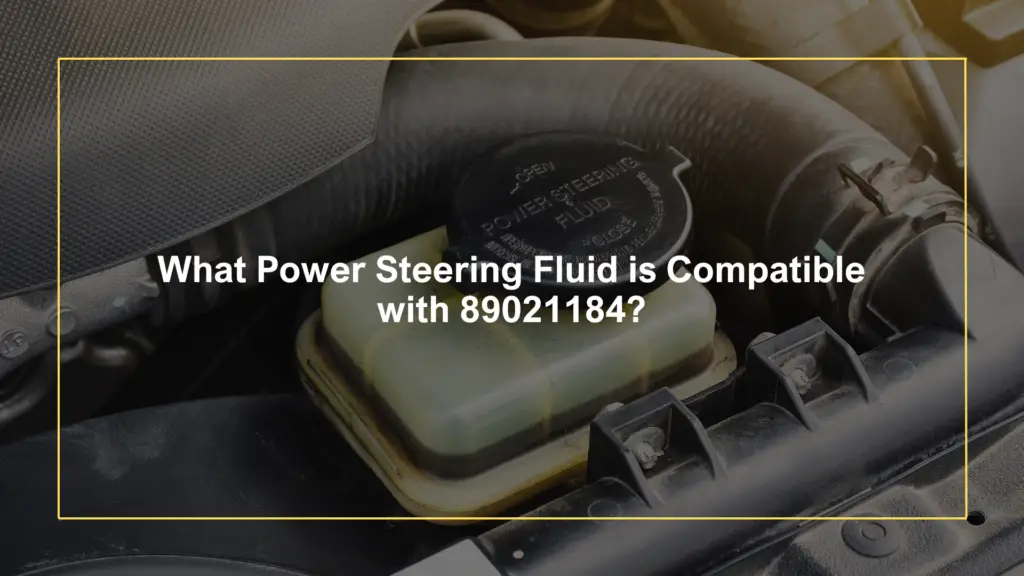Coolant boil in the reservoir is a common problem that many car owners face. But could have caused it? And how to fix this?
The reasons of this issue might be your failed thermostat, blown head gasket, air trapped in the cooling system, ang many more…
In this article, I’ll explain the causes of this problem in the most understandable way. You’d be sure after reading this post, you can check and fix them easily.
Let’s dive in!

Failed Thermostat
The thermostat aids in maintaining the proper temperature of the engine.
When the temperature of the engine becomes too high, the thermostat opens, allowing coolant to flow to the radiator, lowering the temperature. The thermostat closes once the coolant reaches the required temperature.
A failed thermostat can either get stuck in a closed or opened position. A stuck-open thermostat can hinder the engine from becoming sufficiently hot to operate correctly. A stuck-closed thermostat rapidly overheats and may damage the engine.
You will notice one or two symptoms below, regardless of its state of failure.
How to Fix
You will need to change the thermostat to resolve this issue. You have the option of hiring a technician or doing it yourself. It is a simple and inexpensive fix to replace a car’s thermostat.
Replacing the thermostat
Start by locating the thermostat if you choose to do it yourself. When the engine is completely cold, open the radiator cap. Drain the coolant until it is below the thermostat housing level. Then remove the thermostat and gasket from the thermostat housing.
Before installing the new thermostat, any remnants of the old gasket material should be removed. The new thermostat is installed in the proper position after a new gasket is placed. Refill the reservoir with the manufacturer’s recommended coolant up to the fill line. To seal the radiator, tighten the radiator cap.
If you have a new thermostat that was recently installed, gently remove it, inspect and reinstall it.
Related: Subaru Super Coolant Equivalent
Leak Radiator Cap
The radiator cap’s job is to maintain adequate cooling system pressure by maintaining a tight seal. If you have a bad radiator cap, the air will be stuck in the radiator and cause the coolant to leak. The leak at the cap will affect the pressure of coolant flowing through the system, and the fluid will boil.
Inspect the cap when you discover a leak to determine if there is any damage or it appears to be worn or damaged. Replace it right away if there is one.
How to Fix
If your pressure cap is not installed tightly, simply secure it. But if there’s a serious problem, the best solution is to replace this radiator cap.
Replacing Radiator Cap
It’s very easy to replace the radiator cap and you can do it yourself in just a few minutes. Shut down your car and wait for the engine to cool down. Remember that the hot system can make coolant spray and cause severe burns. It’s also important to check the pressure rating on the old cap and use the new one with the same rating. You can consult your owner’s manual to select the proper one.
Once you ensure that the engine is cool, simply unwind the cap slowly. Replace the existing radiator cap with a new one. Start your car and examine your cooling system.
Blown Head Gasket
When a head gasket fails, the water pump’s ability to circulate coolant through the system is impaired, resulting in overheating. When a head gasket blows, air enters the cooling system, causing bubbling. This breach causes coolant to leak from the head gasket into the cylinder head.
As the liquid leaks into the cylinders, the cooling system gradually fills with air, lowering the liquid pressure and causing the fluid to boil. Overheating can occur quickly as a result of a head gasket leak, with white steam flowing from beneath the hood.
Symptoms
- Exhaust produces white smoke
- If there is a steady stream of bubbles, the problem is most likely a blown head gasket.
- Overheating and may misfire
- Steam may start rising from beneath the hood
- The oil has a milky white appearance
- Loss of engine power.
How to Fix
If you suspect the blown head gasket or leaks, you can either replace it completely or using head gasket sealant to fix minor leak.
Using a sealant
A gasket sealant can be used to repair and seal leaks in blown head gaskets. It is a cheap and easy process. If the problem started recently and is minor, you can try this solution. When re-sealant products reach the point of the leak, the sealant hardens into a resin that bonds with the gasket material, restoring gasket function.
Replacing the Head Gasket
If resealing does not work, or the damage is serious, you must replace the head gasket. This is more expensive than re-sealing. This repair necessitates disassembly of the upper half of the engine to reach the gasket, you will likely have to enlist the help of a service garage to do the job.
Air Pockets Trapped in the Radiator
Most cooling systems use sealed hose systems that allow coolant flow within them. But somehow air finds its way to get into this and forms air pockets.
The presence of air within the cooling system prevents coolant from reaching crucial engine components. Thereby increasing the danger of overheating in the system and causing the coolant to boil in the reservoir.
An airlock can happen for many reasons like a faulty radiator hose, the system was not flushed properly, using the wrong coolant… but it’s preferable to get rid of it as soon as possible.
How to Fix
Air pockets trapped in the radiator can be fixed by bleeding. Bleeding a radiator is the process of removing trapped air from your cooling system. This issue can be fixed either way.
Bleeding by Opening the Bleeder Valves
Some vehicles have a special valve designed to remove air from the system. The radiator bleeder valve can be found on some automobiles towards the top or front of the radiator. This is the simplest solution for trapped air as it only requires turning a valve. If you are not sure about the position of your bleeder valve, you can check your manual to know this.
Bleeding a Cooling System with Jack Stands
Place your vehicle in park and use a jack to raise it. Remove the radiator cap and drain as much coolant as possible from the radiator. After that, start the car and let it warm up. Allow the engine to idle for a few moments to let the air out before shutting it down. Once the engine has cooled, add more coolant until it reaches the proper level. Replace the cap, lower the car, and go for a drive.
Related: Bubbles In Transmission Fluid: Causes & Repair Guide
Final Words
You can avoid future costly repairs now if you know what causes coolant to boil in reservoirs. Regular maintenance can also detect a damaged head gasket or a faulty radiator cap, as well as other issues that can cause coolant to boil.
If you notice any of the above-mentioned symptoms, don’t hesitate to fix them. The first solution is to fix it yourself to save money if the problem is minor. The second alternative is to take your car to a professional who will diagnose and fix the problem.
Could you share with us your experience of fixing this problem yourself? Just leave it in the comment box below!
Related Reads
- Low Oil Pressure At Idle: Causes & Repair Guide Understand how low oil pressure can affect engine temperature, potentially leading to coolant boiling in the reservoir – Learn more.
- Bubbles In Transmission Fluid: Causes & Repair Guide Discover how transmission issues, like fluid bubbles, can contribute to overheating and coolant problems in your vehicle – Read more.
- Power Steering Fluid Coming Out of Reservoir Cap: Causes & Solutions Explore how similar issues with power steering fluid can offer insights into why your coolant might be boiling – Find out more.
- Best Oil Pollution Powder Find the best products to manage and clean up coolant spills, ensuring a safe and efficient workspace when addressing coolant boiling issues – Explore here.
- Mopar Coolant Equivalent [OAT & HOAT] Learn about suitable coolant equivalents that meet Mopar standards to ensure you are using the right type to prevent boiling and other issues – Discover now.

![Motorcraft Coolant Equivalent: [Orange & Premium Gold]](https://oilsadvisor.com/wp-content/uploads/2021/07/motorcraft-coolant-1024x576.png)

Pingback: Bubbles In Transmission Fluid: Causes & Repair Guide - Oils Advisor